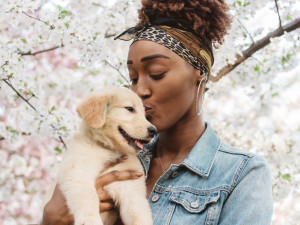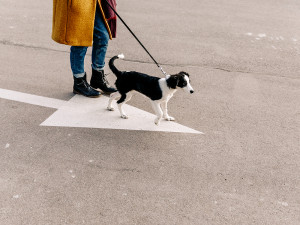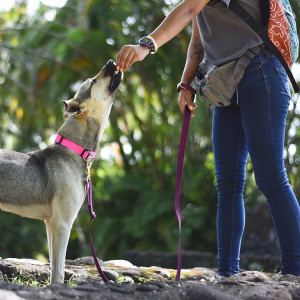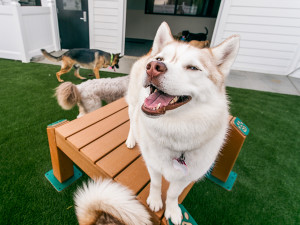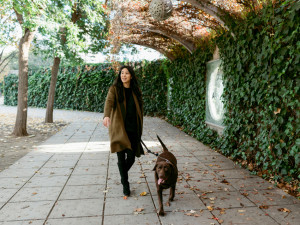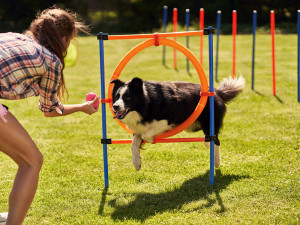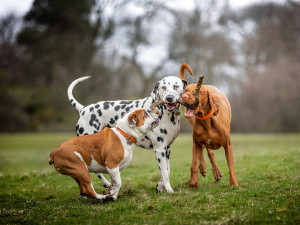How to Prepare Your Dog For Daycare and Dog Walkers
Set your pup up for success.
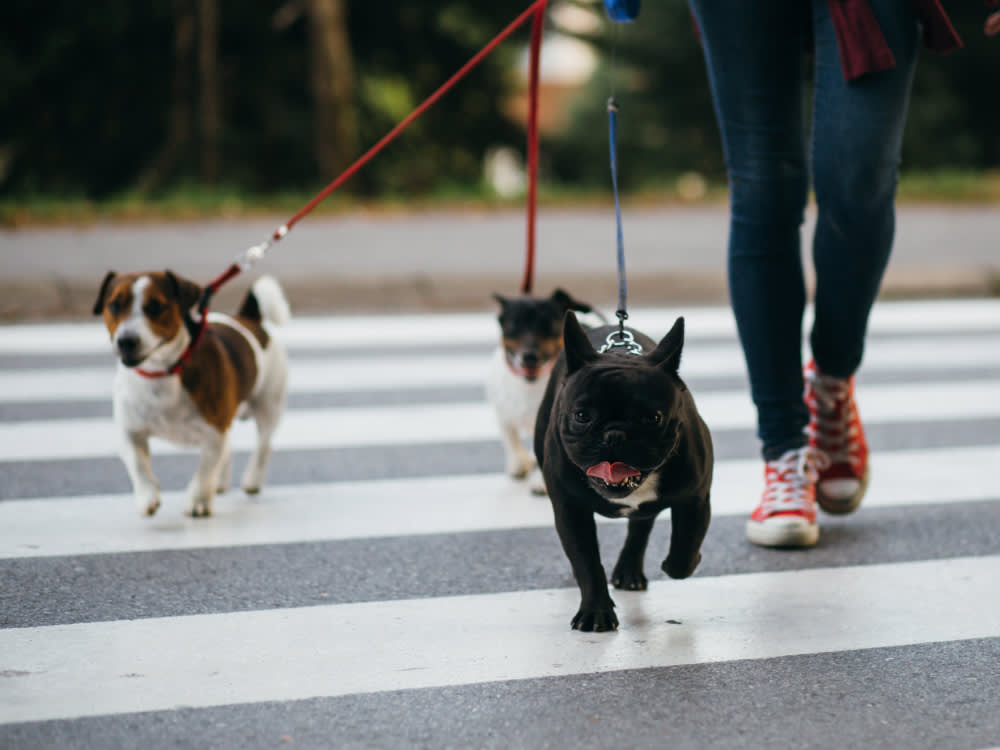
Share Article
To prepare your dog for doggie daycare or a dog walker, give them experiences that are similar to those they will have with these businesses, and teach them the skills they need to succeed in those settings. Train them to respond to common cues and to exhibit good manners when on a leash. Teach them to be comfortable in a crate and happy when interacting with new people and other dogs.
What is the importance of preparing my dog for daycare or a dog walker?
It’s important to prepare your dog for doggie daycare or for a dog walker so they will get the most out of the experiences and be allowed to continue with these services. Your dog will not be invited back if the environment is not good for them, if your dog creates safety issues for the staff or for other dogs, or if it’s too exhausting to manage your dog.
It’s so much easier to raise dogs with help rather than completely on our own, and doggie day care and dog walkers are two great sources of assistance. These services allow your dog to get out and have fun even if you work long hours, are dealing with a health issue, or have any other issue that prevents you from providing all the fun and exercise your dog needs. (Hey, life happens, and that’s why people are there to help.)
Should my dog have any specific training before going to daycare or with a dog walker?
Preparing your dog for doggie daycare is all about making sure your dog has a good time and they do not get in the way of anyone else’s good time — human staff or other dogs. That means, before they go to daycare, they should respond to training cues and be comfortable with other dogs, with new people, and with standard equipment for dogs, such as leashes and crates.

How to prepare for doggie daycare
1. Give your pup practice being social.
To enjoy doggie daycare, a dog must be used to playing with other dogs, both individually and in groups. If your pup is a social butterfly who wants to goof around with every dog they meet and enjoys play sessions, even when multiple dogs are involved, they will probably find daycare a positive experience. If they are not familiar with multi-dog play, it’s wise to give them opportunities to play in a group setting, starting with small groups and moving on to larger groups, assuming they're enjoy it.
Doggie daycare is not the place to teach a dog to like strangers or to be comfortable with other dogs. Imagine trying to change a socially anxious person who is shy and introverted into a social butterfly by sending them to a huge party with dozens or hundreds of people and loud music. That’s a good analogy for trying to teach a dog to be more social by sending them to doggie daycare. It’s just too intense and will likely be a negative experience that could actually make them less social.
2. Work on recalls and other cues.
Work on your dog’s recall so they will come when a daycare staff member calls them; this is important because they may need to call your pup away from potentially problematic situations. I also recommend teaching them to sit when they greet people and to walk nicely on a leash so the staff members will enjoy their interactions with your dog.
3. Crate-train your dog.
Teach your dog to be comfortable in a crate if the daycare facility uses them. Many daycares have dogs spend some time playing in groups and some time on breaks, resting in crates.
4. Try a meet-and-greet.
Before your dog attends doggie daycare without you, familiarize them with the actual facility. Pop in for a quick meet-and-greet with the staff and a walk-around, so the sights, sounds, and smells are not a shock to them the first time you leave them there.
When you do take your dog there for their first day, leave them for only an hour or so, even if you must pay for the whole day. It’s far better to leave them wanting more than for them to become overwhelmed and exhausted by being active — and awake, quite frankly — for so long. If that experience is a good one and your dog seems happy (based on what you observe and what the staff tells you), the next step is for them to spend a few hours there, and then if that goes well, to spend the whole day there.
5. Understand your dog’s needs
Keep in mind that not every dog enjoys doggie daycare — and that’s OK. Some dogs find it overwhelming — more like a schoolyard fight than a party. Other dogs exhibit such high levels of arousal that they are incapable of being their best selves. Dogs can sometimes be trained to handle the situation better, but often, if they’re scared or get too revved up, they may simply not be good candidates for spending all day with a large group of dogs. If this proves to be the case with your dog, understand that it’s not a failing on their part; it’s all about the dog and their particular personality and needs.
Doggie daycare is great for many dogs, but it can be a negative experience for others. Communicate with daycare staff to provide information about your dog's behavior, preferences, and any special needs, and only keep sending your dog to doggie daycare if it is working out for your dog. It can be a challenge to answer the question, “How do I know if my dog likes daycare?” but it helps to observe your dog when you arrive to see if they are eager to be there or not, and also to watch your dog’s body language at daycare to determine if they are relaxed, comfortable, and happy. If they look fearful or show signs of stress, they are presumably not a dog who likes the doggie daycare experience they have been having. Choosing a high-quality doggie daycare that suits your dog is an important way to increase the chances of a positive experience for your dog.
What are the pros and cons of doggie daycare?
There are pros and cons to doggie daycare, and it’s important to evaluate on a regular basis whether the pros outweigh the cons for your dog. On the pro side, doggie daycare offers your dog the chance to have a fun, stimulating day rather than being home alone when you are at work. The opportunity to play, to be around people and dogs, and to go to a place other than home benefits many dogs. Doggie day care offers plenty of enrichment, and they will probably be tired when you come home, so you can rest and relax rather than be the recreation director all evening.
On the downside, some dogs find doggie daycare stressful and upsetting. They may become overly aroused with all the stimulation and may become crabby and defensive because they need more space and time to relax on their own. Bad experiences at daycare make some dogs less able to handle other dogs. Others become so excitable around other dogs that they act in inappropriate ways, such as leaping on them and generally being rude whenever they see a dog.
Doggie daycare, puppies, and socialization
If you’re wondering whether doggie daycare is good for socializing your puppy, that’s a hard no. Socialization is exposing a puppy to a variety of new experiences (positive ones!) during the critical period of their lives from three to 14 weeks and only applies to puppies. Most doggie daycares will not accept a puppy who is younger than four months old (which is too old to still be in their socialization stage).
That is good because there is too high a chance of a bad experience in a dog’s early weeks that could have long-term effects. This is the same reason puppies, especially young ones, should not go to dog parks. If clients ask me when a puppy can go to daycare, my answer is that they probably shouldn’t go until they are in late adolescence. Though some facilities with small groups monitored constantly by knowledgeable staff create good experiences for young dogs, there’s always a risk of a bad experience negatively affecting them.
How to prepare your dog for a dog walker
To prepare your dog for a dog walker requires teaching your dog to be comfortable with every aspect of the experience and to be polite and easily manageable during walks. Specifically, the advance preparation for dog walkers means teaching your dog to be an enjoyable dog to walk with good leash manners and good social skills.
1. Get your pup used to walking gear.
To prepare your dog to be walked by a professional dog walker, make sure they are accustomed to the gear the dog walker uses. It’s important that they’re walked using a familiar, safe, and comfortable leash (and collar or harness) that also works for the dog walker.
2. Teach them good leash manners.
Dog walkers greatly appreciate if pups have been taught to remain calm while the collar or harness is put on and/or their leash is being attached, whether that means a dog sits or simply stands still. If your dog has a tendency to pull, teach them to walk nicely on a leash, which will make it more likely that your dog and the dog walker will have positive experiences during their outings.
3. Help your dog to feel comfortable with strangers.
Finally, it’s important to make sure that your dog will be comfortable with a dog walker entering your home. Many dogs are happy when anybody comes over at any time. If this describes your dog, great! If that’s not the case and your dog is uncomfortable with a stranger walking in when they’re home alone, set up situations in which people come over while you are there and toss treats or toys to help your dog feel happy about visitors.
Once people are not strangers to them, your dog will be better able to handle them entering when you are not there. If you’re concerned that your dog might act aggressively to a visitor or be really nervous around them, consult with a canine behaviorist who can help your dog with this issue.
What are the pros and cons of dog walkers?
Generally, the pros of dog walkers are that your dog gets out for some fun and exercise. The cons are that you are trusting someone else to keep your dog safe and happy. That’s only possible if the person has the experience to understand your dog’s emotions and behaviors and act accordingly. Not every dog is a good match for dog walking services. If your dog is fearful of strangers or highly reactive to other dogs, consider contacting a professional behaviorist or trainer who is qualified to address these issues.
They’ll be able to help improve the situation and let you know if and when your dog is ready to go on walks with a dog walker. If your dog is easy going and agreeable on walks no matter what they encounter, and doesn’t have any alarming habits such as slipping out of their collar or trying to run away, a wide variety of responsible dog walkers will be a good match. If your dog is aggressive, reactive, fearful, or a skilled escape artist, then only a dog walker who specializes in handling these issues will be appropriate to consider hiring to walk your dog. But definitely do your research: Even that is no guarantee that the benefits will outweigh the costs.
FAQs (People also ask):
How can I monitor my dog’s progress at daycare or with a dog walker?
In addition to communication from the staff about your dog, monitor their progress by observing their body language at drop-off and pick-up and when they see their dog walker.
What information should I provide to the daycare or dog walker?
Let the doggie daycare or dog walker know what your dog loves, what might upset your dog, what cues they know, and if they have any health issues including allergies.

Karen B. London, PhD, CAAB, CPDT-KA
Karen B. London is a certified applied animal behaviorist (CAAB) and certified professional dog trainer (CPDT) who specializes in working with dogs with serious behavioral issues, including aggression. She has written for a variety of magazines including The Bark, Clean Run, and the APDT Chronicle of the Dog, and has published in scientific journals including Behavioral Ecology and Sociobiology, Ethology, Ecology, and Evolution, the Journal of Insect Behavior, and Insectes Sociaux. She is the author of seven books about dog training and canine behavior, including the forthcoming My Dog's Mystery Adventure: And Other Stories From a Canine Behaviorist and Dog Trainer.
Related articles
![Border collie dog and a woman on an agility field]()
A Crash Course on Dog Agility Training
5 reasons to get your dog in the agility game, from burning energy to building confidence.
![Boston terrier being stubborn]()
Dog Training — DIY or Hire a Pro?
When it’s time to call in reinforcements.
![girl with blue hair starting puppy training with white dog]()
Puppy Training 101: How to Train a Puppy
You gotta start somewhere.
Are Dog Parks Good for Socialization?
Help! Should I take my young dog to the dog park for “socialization”?
![man and lab puppy on park road]()
When, Exactly, Should You Vaccinate Your Puppy?
If it’s time for a round of shots (no, not that kind), follow this guide.
